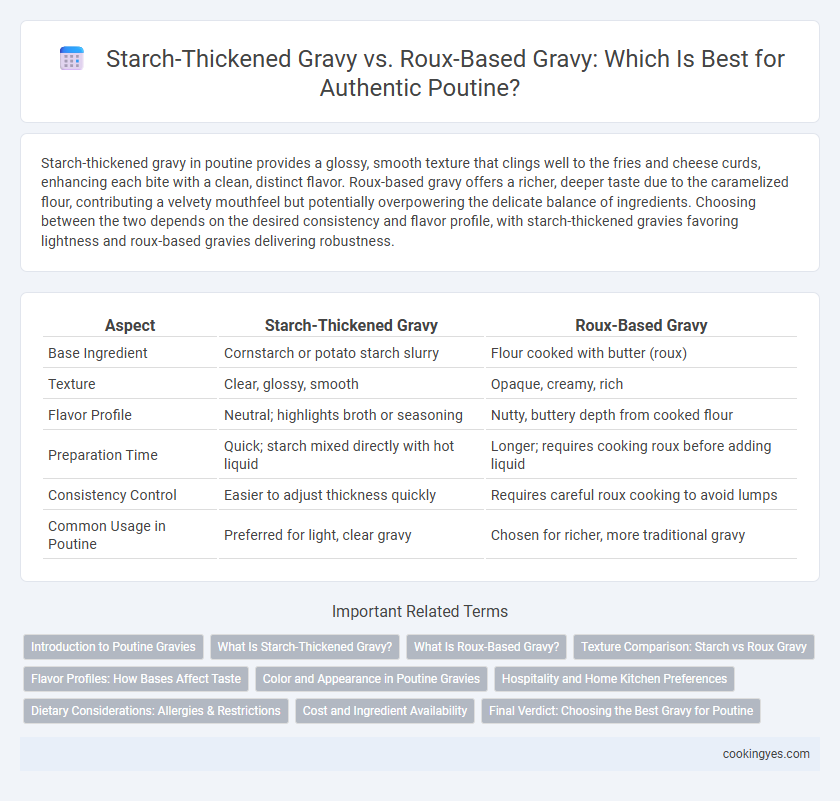Starch-thickened gravy in poutine provides a glossy, smooth texture that clings well to the fries and cheese curds, enhancing each bite with a clean, distinct flavor. Roux-based gravy offers a richer, deeper taste due to the caramelized flour, contributing a velvety mouthfeel but potentially overpowering the delicate balance of ingredients. Choosing between the two depends on the desired consistency and flavor profile, with starch-thickened gravies favoring lightness and roux-based gravies delivering robustness.
Table of Comparison
| Aspect | Starch-Thickened Gravy | Roux-Based Gravy |
|---|---|---|
| Base Ingredient | Cornstarch or potato starch slurry | Flour cooked with butter (roux) |
| Texture | Clear, glossy, smooth | Opaque, creamy, rich |
| Flavor Profile | Neutral; highlights broth or seasoning | Nutty, buttery depth from cooked flour |
| Preparation Time | Quick; starch mixed directly with hot liquid | Longer; requires cooking roux before adding liquid |
| Consistency Control | Easier to adjust thickness quickly | Requires careful roux cooking to avoid lumps |
| Common Usage in Poutine | Preferred for light, clear gravy | Chosen for richer, more traditional gravy |
Introduction to Poutine Gravies
Poutine gravies traditionally vary between starch-thickened and roux-based formulations, each impacting texture and flavor differently. Starch-thickened gravies offer a glossy, lighter consistency ideal for soaking fries and melting cheese curds without overpowering. Roux-based gravies provide a richer, deeper flavor with a velvety texture achieved through butter and flour cooking, creating a heartier complement to classic Quebec-style poutine.
What Is Starch-Thickened Gravy?
Starch-thickened gravy is made by dissolving starches like cornstarch or arrowroot in water before adding them to the liquid base, creating a smooth, glossy texture that thickens quickly upon heating. This method differs from roux-based gravy, which starts with cooking flour in fat, resulting in a richer, butter-infused flavor and a slightly heavier consistency. In poutine, starch-thickened gravy offers a lighter, more translucent sauce that clings well to fries and cheese curds without overpowering their taste.
What Is Roux-Based Gravy?
Roux-based gravy is a classic French sauce made by cooking equal parts flour and fat, typically butter, until it forms a smooth paste that thickens the gravy. This method ensures a rich, velvety texture and deeper flavor compared to starch-thickened gravies, which rely solely on cornflour or potato starch for thickening. In poutine, roux-based gravy provides a more complex, savory taste that complements the crispy fries and cheese curds perfectly.
Texture Comparison: Starch vs Roux Gravy
Starch-thickened gravy in poutine typically offers a glossy, smooth texture with a slightly gelatinous consistency that clings well to the fries and cheese curds. Roux-based gravy, made from butter and flour, provides a richer, creamier mouthfeel with a more complex, toasted flavor and a thicker, velvety body. The choice between starch and roux impacts the gravy's viscosity and how it interacts with the components of poutine, affecting the overall sensory experience.
Flavor Profiles: How Bases Affect Taste
Starch-thickened gravy in poutine offers a lighter, cleaner flavor with a smooth texture that highlights the natural meat stock essence, creating a savory and slightly sweet profile. Roux-based gravy delivers a richer, deeper taste with a velvety, buttery consistency that imparts a toasted, nutty flavor, enhancing the overall mouthfeel and complexity. The choice between these gravies influences the poutine's balance, where starch thickeners emphasize clarity and meatiness, while roux enriches with depth and indulgence.
Color and Appearance in Poutine Gravies
Starch-thickened gravy in poutine typically has a clearer, glossier appearance with a lighter brown color, showcasing a more translucent finish that highlights the texture of the fries and cheese curds. Roux-based gravy, by contrast, offers a deeper, richer brown hue and a matte, opaque look due to the caramelization of flour and fat during cooking, providing a visually robust and hearty presence. The color contrast in roux-based gravies enhances the rustic appeal of traditional poutine, while starch-thickened versions emphasize a cleaner, more refined presentation.
Hospitality and Home Kitchen Preferences
Starch-thickened gravy offers a clear, glossy finish and faster preparation, making it ideal for high-volume hospitality settings where consistency and speed are essential. Roux-based gravy, with its rich, deep flavor and velvety texture, is favored in home kitchens for its traditional taste and ability to develop complex aromas through slow cooking. Both gravies contribute distinctly to poutine, with hospitality professionals prioritizing practicality and home cooks valuing craft and depth of flavor.
Dietary Considerations: Allergies & Restrictions
Starch-thickened gravy for poutine often uses cornstarch or potato starch, making it naturally gluten-free and suitable for individuals with celiac disease or gluten intolerance. Roux-based gravy contains flour and butter, which may pose issues for those with gluten allergies or dairy restrictions. Choosing starch-thickened gravy provides a safer alternative for vegan, gluten-free, and dairy-sensitive diets without compromising traditional poutine flavors.
Cost and Ingredient Availability
Starch-thickened gravy for poutine is often more cost-effective due to the affordability and wide availability of cornstarch or potato starch compared to the butter and flour needed for roux-based gravy. Ingredients for starch-thickened gravy are typically shelf-stable and readily sourced in bulk, reducing overall production costs. Roux-based gravy requires more careful preparation and higher-cost dairy fats, which can limit ingredient availability and increase expenses, especially in large-scale or commercial poutine production.
Final Verdict: Choosing the Best Gravy for Poutine
Starch-thickened gravy offers a glossy, smooth texture that clings well to fries and cheese curds, enhancing the classic poutine experience with a lighter mouthfeel. Roux-based gravy, made from butter and flour, provides a rich, deep flavor and a thicker consistency that adds robustness to the dish. For the best poutine, starch-thickened gravy is often preferred due to its balanced texture and ability to meld seamlessly with the key ingredients.
Starch-thickened gravy vs roux-based gravy for poutine Infographic

 cookingyes.com
cookingyes.com